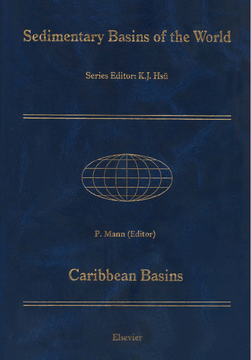
Additional Information
Book Details
Abstract
This 21-chapter volume provides a regionally-comprehensive collection of original studies of Caribbean basins conducted by academic and petroleum geologists and geophysicists in the early and mid-1990s. The common tectonic events discussed in the volume including the rifting and passive margin history of North and South America that led to the formation of the Caribbean region; the entry of an exotic, Pacific-derived Great Arc of the Caribbean at the leading edge of the Caribbean oceanic plateau; the terminal collision of the arc and plateau with the passive margins fringing North and South America; and subsequent strike-slip and accretionary tectonics that affected the arc-continent collision zone.
Two introductory chapters (Part A) utilize recent advances in quantitative plate tectonic modeling and satellite-based gravity measurements to place the main phases of Caribbean basin formation into a global plate tectonic framework. Nineteen subsequent chapters are organized geographically and focus on individual or groups of genetically-linked basins. Part B consists of five chapters which mainly focus on basins overlying the North America plate in the Gulf of Mexico, Cuba and the Bahamas that record its rifting from South America in late Jurassic to Cretaceous time. Part C has six chapters that focus on smaller, usually heavily faulted and onshore Cenozoic basins of the northern Caribbean that formed in response to arc collisional and strike-slip activity along the evolving North America-Caribbean plate boundary. The two chapters in Part D focus on Cenozoic basins related to the Lesser Antilles arc system of the eastern Caribbean. Part E is comprised of three chapters on the Jurassic-Recent sedimentary basins of the eastern Venezuela and Trinidad area of the southeastern Caribbean. These basins reflect both the Jurassic-Cretaceous rifting and passive margin history of separation between the North and South America plates as well as a much younger phase of Oligocene to recent transpression between the eastward migrating Lesser Antilles arc and accretionary wedge and the South America continent. The three chapters of Part F contain deep penetration seismic reflection and other geophysical data on the largely submarine Cretaceous Caribbean oceanic plateau that forms the nucleus of the present-day Caribbean plate.
(J. Butterlin)
Caribbean Basins et un ouvrage d'une grande qualité, aussi bien dans son contenu que dans sa forme, et bénéficie d'une illustration abondante qui en facilite la lecture et la compréhension. Il sera indispensable à tous les chercheurs intéressés par l'évolution des bassins caraïbes.
Geochronique, No 74,
